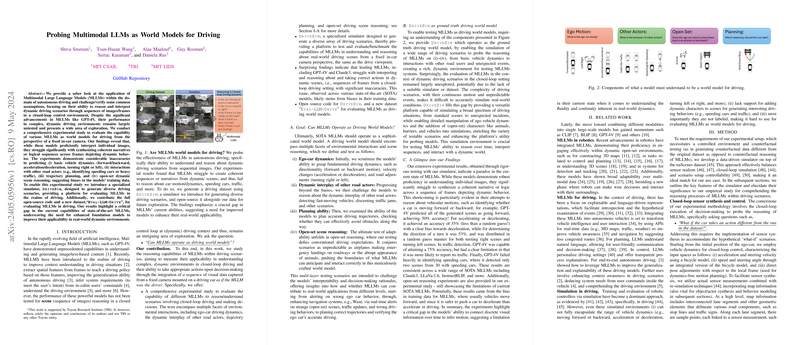Evaluating Multimodal LLMs for Autonomous Driving
Introduction
In the domain of AI and autonomous driving, the potential role of Multimodal LLMs (MLLMs) such as GPT-4V has been an area of both excitement and scrutiny. The primary goal was to determine if MLLMs can act as world models in autonomous driving scenarios, particularly through their ability to process and make decisions based on sequential imagery from a car's camera view.
Core Challenge in Dynamic Driving Environments
The allure of employing MLLMs in autonomous vehicles lies in their sophisticated capabilities to integrate and interpret multimodal data (like images and texts). However, when these models are tested in dynamic, less controlled environments such as driving, their efficacy can be significantly different.
Sequential Frame Analysis
The trials explored how well these AI models could stitch together coherent narratives from sequences of driving images. The dynamic aspects, including vehicle motion, other moving objects, and rapid changes in the environment, proved to be particularly challenging for the models.
Key Findings
One surprising discovery was the models' overall weakness in logical sequence synthesis and dynamic reasoning:
- Basic vehicle dynamics predictions like forward or backward movement were often flawed, showing biases toward certain actions irrespective of the scenario (e.g., constant prediction of forward movement).
- Performance deteriorated further when the models were asked to interpret complex interactions with other vehicles or unexpected road events.
The Role of Simulation
To effectively test these models, the paper introduced a specialized driving simulator that could generate a wide range of road situations. This tool allowed researchers to rigorously challenge the predictive and reasoning powers of MLLMs under diverse conditions.
Future Outlook
Despite the current limitations, the utilitarian value of improving MLLMs for driving applications remains significant. Enhanced models could potentially transform how autonomous vehicles interpret their surroundings, make decisions, and learn from diverse driving conditions. However, substantial improvements in model training, including better dataset representation and advanced simulation capabilities, are necessary steps forward.
Conclusion
While MLLMs like GPT-4V have showcased impressive abilities in controlled environments, their application as reliable world models in autonomous driving still faces significant hurdles. The current paper shed light on critical gaps, primarily in dynamic reasoning and logical sequence formation across driving frames. Addressing these challenges will be pivotal in advancing the reliability and safety of AI-driven autonomous vehicles in real-world scenarios.
